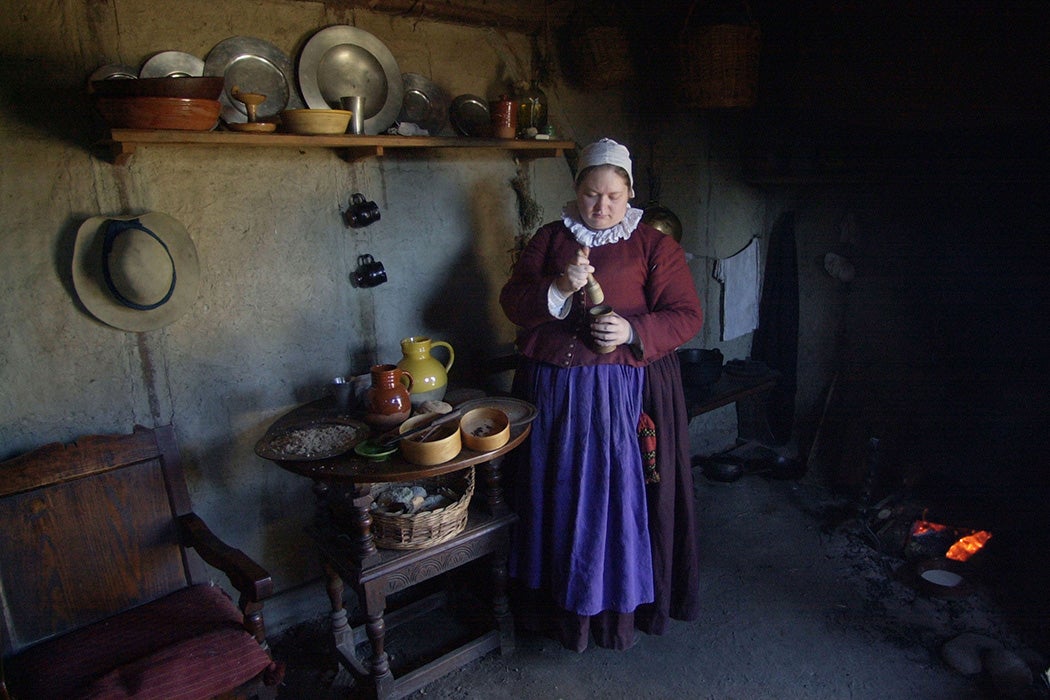We visit “living history” destinations like Colonial Williamsburg and Plimoth Plantation to learn about life in the long-ago times. But historian Malgorzata J. Rymsza-Pawlowska writes that these spots are also tied to more recent history: the countercultural movements of the 1960s and ’70s.
Rymsza-Pawlowska notes that the first iterations of living history museums were part of the Colonial Revival movement. In the 1920s, Rockefeller money financed the creation of Colonial Williamsburg in Virginia while Henry Ford created Greenfield Village in Michigan. These sites were less about the rigorous use of historical scholarship to inform the public than celebrating an idealized version of a rustic American past.
For example, Plimoth Plantation, a Massachusetts project that began in 1947 with the support of investment banker Henry Hornblower, was designed as a “memorial to our Pilgrim Fathers.” Inside houses labeled with the names of families believed to have lived there, visitors found elaborate but anachronistic eighteenth- or nineteenth-century antique furniture. Both the mannequins who inhabited the buildings and the human guides who presented the buildings wore polyester reproductions of the white costumes featured in nineteenth-century books about Pilgrims.
This changed with the arrival of James Deetz, an anthropologist and archaeologist by training who became assistant director at Plimoth in 1967. He installed reproductions of simple seventeenth-century furniture and eliminated the signs and mannequins. New historical costumes were made of natural materials and dyed in bright colors that real Pilgrims had favored. The guides became historical interpreters, who actually raised livestock and farmed crops using historically accurate techniques. By the mid-1970s, they began using first-person language, fully taking on the roles of colonists.
Similar, if less dramatic, changes occurred in the 1960s and ’70s at other living history museums. Rymsza-Pawlowska writes that these innovations “sought to bring the practice from something like civic religion towards scholarly methodology.” At Colonial Williamsburg, this included the beginnings of a trend toward exploring the lives of enslaved and free Black residents. Meanwhile, people across the country began establishing smaller “living history farms” where historians could learn about past agricultural techniques through experimentation. In 1970, academics and museum officials established the Association for Living History Farms and Agricultural Museums (ALHFAM).
Weekly Newsletter
Rymsza-Pawlowska writes that it’s no coincidence these efforts occurred when they did. For one thing, this was a time when academics were increasingly interested in social history, studying the day-to-day lives of ordinary people in the past. For another, many of the young people working at the reworked living museums were products of the era’s counterculture.
In fact, many of the communes and collectives that emerged in this time also took inspiration from history, as with the Bay Area Diggers, who styled themselves after the seventeenth-century radicals of the same name. Commune residents often ordered supplies from the same companies and read the same how-to guides as ALHFAM members. As folklorist Virginia Wolf Briscoe wrote at the time, like commune living, living history “was an opportunity for another kind of celebration of unity and simplicity.”
Teaching Tips:
- Public History and School: International Perspectives, Ed. Marko Demantowsky (2018)
- “Historic Environment Education: Using Nearby History in Classrooms and Museums,” by John Hunner (2011)
- “Playing to Strength: Teaching Public History at the Turn of the 21st-Century,” by Marla R. Miller (2004)
- “Te Upoko o Mata’oho (Mangere Mountain): The Performative Tensions of a Living Museum,” by Joce Jesson (2010)
Support JSTOR Daily! Join our membership program on Patreon today.







